USS Cod
USS Cod

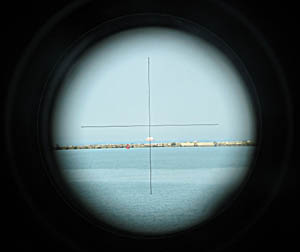
View Through the Periscope
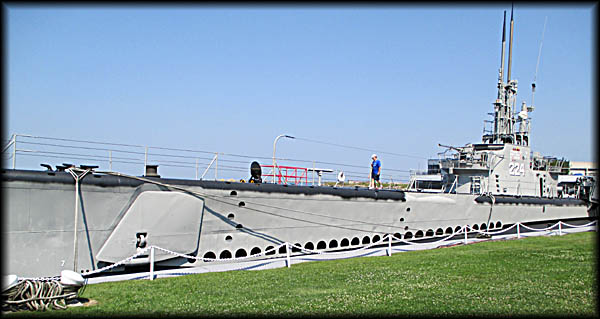
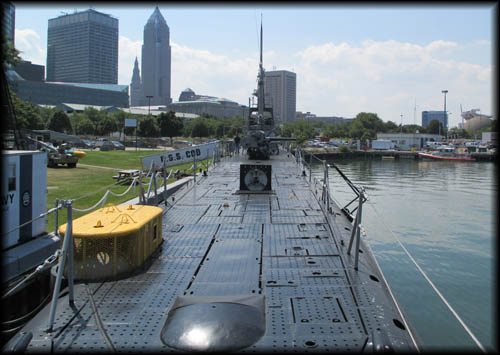
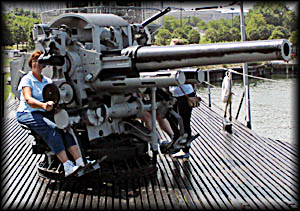
You can play with
the main deck gun.
the main deck gun.
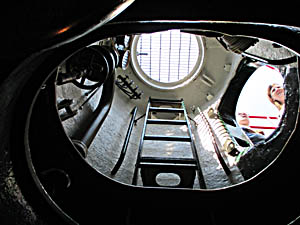
To go below or aloft you had to pass through on of the Cod's hatches.
USS Cod
While still a child, someone told me that during World War II the Germans had gotten a U-boat into Lake Erie. Having had a healthy imagination in those days, I naturally believed it. Alas, age and knowledge erased this little fantasy when I better understood the reality. For this to be true, the U-boat would somehow have had to have gotten into the lake—this before the St. Lawrence Seaway—then find a supply base for victuals, weapons, and fuel, all while navigating through the shallowest of the Great Lakes. Yet the tale may have a kernel of truth: a WWII-era submarine, the USS Cod, does reside in Lake Erie. In 1959 the U.S. Navy towed her from Philadelphia to Lake Erie via the St. Lawrence Seaway. She docked in Cleveland and served as a training center until 1971, the year in which the Navy decided to scrap her.
Cleveland residents had other ideas. The boat had always attracted tourists, especially school children, so a group calling itself the Cleveland Coordinating Committee to Save Cod incorporated with the goal of preserving her, bolstering its argument by pointing out that the Cod’s diesel engines had come from a Cleveland General Motors plant, meaning she had in effect started life in the city. The Committee ultimately prevailed, and the Cod became a major tourist attraction. Since that time, her caretakers have worked to restore her to her original condition so visitors can get a sense of life on board a WWII American submarine. During the war she had served in the Pacific with distinction, her operational history being detailed here. Such accounts give you raw details about her history and operations but don’t substitute for a visit to the real thing.
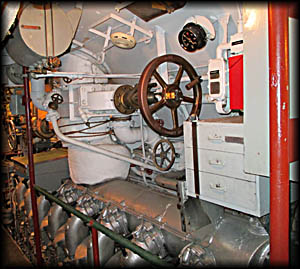
One of the Cod's Diesel Engines
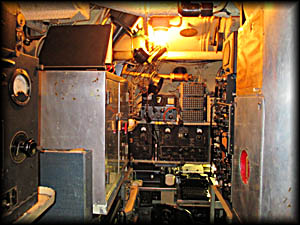
Radio Room

Before boarding, you will probably want to check out two related attractions: a periscope and a Mark 14 torpedo. The working periscope rises about twenty feet into the air. I found seeing though its scope more difficult than expected. You have to get your eyes aligned just right or you see nothing but black.
The Mark 14 torpedo, a more recent acquisition, sets upon a transportation cart. The U.S. Navy used these 3,000 pound instruments of destruction from 1938 to 1976. They traveled at about fifty-three miles per hour, a pace they could keep up for about two miles. WWII enthusiasts will know that they had an infamous beginning. Their top secret magnetic detonator had a defect that made many of them duds. Worse, it took the Navy’s Bureau of Weapons two years to admit to and fix the issue.
The Mark 14 torpedo, a more recent acquisition, sets upon a transportation cart. The U.S. Navy used these 3,000 pound instruments of destruction from 1938 to 1976. They traveled at about fifty-three miles per hour, a pace they could keep up for about two miles. WWII enthusiasts will know that they had an infamous beginning. Their top secret magnetic detonator had a defect that made many of them duds. Worse, it took the Navy’s Bureau of Weapons two years to admit to and fix the issue.
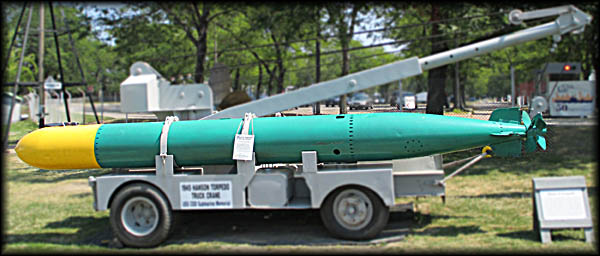
Climbing onto the Cod’s main deck involves nothing more difficult than ascending a gangplank. Once on board, you explore the forward deck gun. Two people can sit themselves onto its duel seats to control it, the one on the right rotating it in a 360 degree arc, the one on the left controlling the barrel’s elevation. I find it amazing that a gun submerged in salt water for long periods of time could still work once surfaced, but it did thanks to corrosion-resistant steel.
Having never before set foot on a World War II-era submarine of any type, I found myself learning all sorts of little details about these boats I never knew. Take the main deck. Rather than being made out of solid metal to keep the water out as I’d expected, it consisted open wooden planking and metal plating that allowed water to flood the space between it and the solid metal hull beneath.
To go below, one has to use the original hatches, a venture that made me feel like a yogi because of all the twisting and turning I had to do. For those incapable of climbing through tight spaces, descending and ascending tricky ladders, or who have a fear of heights, you might want to reconsider a visit. Tall people, on the other hand, will discover the venture less daunting than they might think. Save for going through the bulkheads, plenty of headroom exists.
Once below, you start the tour in the bow at the forward torpedo bay and make your way back to the aft torpedo bay. No tour guide accompanies you. Rather, you will encounter a series of buttons that, when pushed, start prerecorded lectures on given areas, these supplemented by information signs.
Having never before set foot on a World War II-era submarine of any type, I found myself learning all sorts of little details about these boats I never knew. Take the main deck. Rather than being made out of solid metal to keep the water out as I’d expected, it consisted open wooden planking and metal plating that allowed water to flood the space between it and the solid metal hull beneath.
To go below, one has to use the original hatches, a venture that made me feel like a yogi because of all the twisting and turning I had to do. For those incapable of climbing through tight spaces, descending and ascending tricky ladders, or who have a fear of heights, you might want to reconsider a visit. Tall people, on the other hand, will discover the venture less daunting than they might think. Save for going through the bulkheads, plenty of headroom exists.
Once below, you start the tour in the bow at the forward torpedo bay and make your way back to the aft torpedo bay. No tour guide accompanies you. Rather, you will encounter a series of buttons that, when pushed, start prerecorded lectures on given areas, these supplemented by information signs.
I found it surprising that every compartment, including the torpedo bays and engine rooms, contained canned good squirreled away in otherwise unused nooks and crannies. With space limited and the quantity needed to feed all on board great, this makes much sense. Yet you never see that in movies with diesel-electric subs.
During WWII few survived when their submarine sank. Aware of this, I had always presumed the Navy didn’t bother to provide a potential means of escape. It turns out it did. On board the Cod and other Navy subs in that era one could find the Momsen Lung, a primitive rebreather meant for use in shallow water. Not only did it fail to work well—it saved a meager five men during its time of service—the Navy warned it could kill users and suggested anyone in possession of one destroy it.
For those of you who have seen the movie Operation Petticoat, you might recall the crew of the USS Sea Tiger painted its boat pink for lack of gray paint. While no American submarine ever sailed while this color, the Cod did have a pink periscope! At the time the Navy believed it reflected other colors better than any other, aiding in its camouflage. Whether this really worked or not I couldn’t say, but one of the Cod’s commanders noted in his log he thought it did.
At the tour’s end we exited via hatch closest to the stern. This required quite a bit of work. Once at the top, we had to pull ourselves onto the deck via hand rails at the hatch’s mouth. We disembarked as tourists who had quite enjoyed themselves.🕜
During WWII few survived when their submarine sank. Aware of this, I had always presumed the Navy didn’t bother to provide a potential means of escape. It turns out it did. On board the Cod and other Navy subs in that era one could find the Momsen Lung, a primitive rebreather meant for use in shallow water. Not only did it fail to work well—it saved a meager five men during its time of service—the Navy warned it could kill users and suggested anyone in possession of one destroy it.
For those of you who have seen the movie Operation Petticoat, you might recall the crew of the USS Sea Tiger painted its boat pink for lack of gray paint. While no American submarine ever sailed while this color, the Cod did have a pink periscope! At the time the Navy believed it reflected other colors better than any other, aiding in its camouflage. Whether this really worked or not I couldn’t say, but one of the Cod’s commanders noted in his log he thought it did.
At the tour’s end we exited via hatch closest to the stern. This required quite a bit of work. Once at the top, we had to pull ourselves onto the deck via hand rails at the hatch’s mouth. We disembarked as tourists who had quite enjoyed themselves.🕜
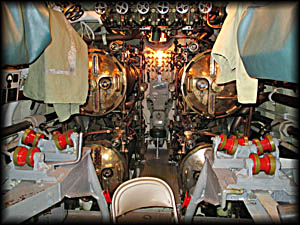
Aft Torpedo Bay
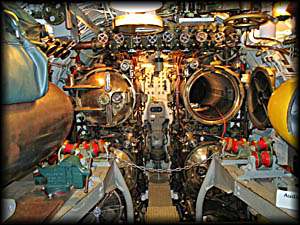
Forward Torpedo Bay
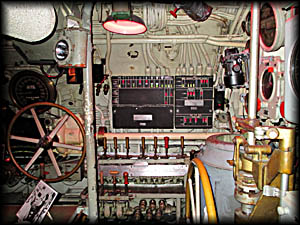
Ballast Controls
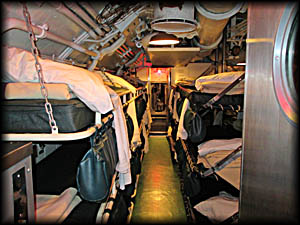
Bunk Room
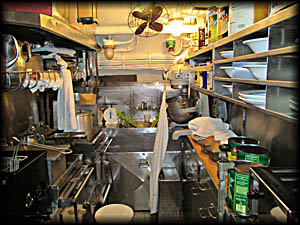
Main Galley
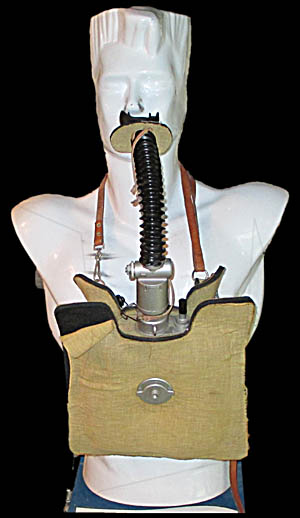
Momsen Lung